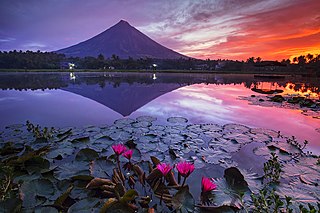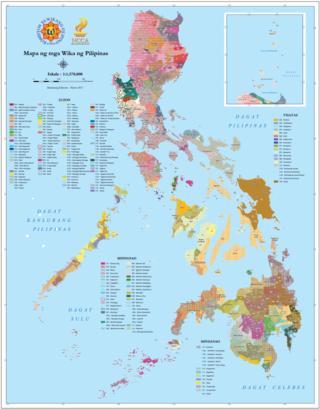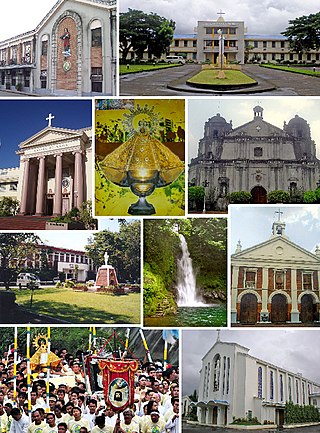
Jose Jason Llagas Chancoco is a multi-awarded[ citation needed ] contemporary Bicolano writer in Bikol, Iriganon, Filipino, and English languages. [1]
His first book is Pagsasatubuanan: Poetikang Bikolnon launched in 2009. [2]

Jose Jason Llagas Chancoco is a multi-awarded[ citation needed ] contemporary Bicolano writer in Bikol, Iriganon, Filipino, and English languages. [1]
His first book is Pagsasatubuanan: Poetikang Bikolnon launched in 2009. [2]

Albay, officially the Province of Albay, is a province in the Bicol Region of the Philippines, mostly on the southeastern part of the island of Luzon. Its capital is the city of Legazpi, the regional center of the whole Bicol Region, which is located in the southern foothill of Mayon Volcano.

The Bicol Region, commonly shortened to Bicol and designated as Region V, is an administrative region of the Philippines. Also referred to as Bicolandia, it comprises six provinces, four on the Bicol Peninsula : Albay, Camarines Norte, Camarines Sur, and Sorsogon, and two off the shore: Catanduanes and Masbate.

Camarines Sur, officially the Province of Camarines Sur, is a province in the Philippines located in the Bicol Region on Luzon. Its capital is Pili and the province borders Camarines Norte and Quezon to the northwest, and Albay to the south. To the east lies the island province of Catanduanes across the Maqueda Channel.

Camarines Norte, officially the Province of Camarines Norte, is a province in the Philippines located in the Bicol Region in Luzon. Its capital is Daet. The province borders Quezon to the west, Camarines Sur to the south, and the Philippine Sea to the north. It has historically been a Bikol-speaking region. However, there has been a language shift in recent years to Tagalog, which is more commonly used nowadays.

There are some 130 to 195 languages spoken in the Philippines, depending on the method of classification. Almost all are Malayo-Polynesian languages native to the archipelago. A number of Spanish-influenced creole varieties generally called Chavacano along with some local varieties of Chinese are also spoken in certain communities. The 1987 constitution designates Filipino, a standardized version of Tagalog, as the national language and an official language along with English. Filipino is regulated by Komisyon sa Wikang Filipino and serves as a lingua franca used by Filipinos of various ethnolinguistic backgrounds.
The Central Philippine languages are the most geographically widespread demonstrated group of languages in the Philippines, being spoken in southern Luzon, Visayas, Mindanao, and Sulu. They are also the most populous, including Tagalog, Bikol, and the major Visayan languages Cebuano, Hiligaynon, Waray, Kinaray-a, and Tausug, with some forty languages all together.
Albay Bikol, or simply Albayanon is a group of languages and one of the three languages that compose Inland Bikol. It is spoken in the southwestern coast of Albay, and northwestern Sorsogon. The region is bordered by the Coastal Bikol and Rinconada Bikol speakers. The latter is the closest language of Albay Bikol and is mutually intelligible. They are both included in Inland Bikol group of languages.

Naga, officially the City of Naga or the Pilgrim City of Naga, is a 1st class independent component city in the Bicol Region of the Philippines. According to the 2020 census, it has a population of 209,170 people.

The Bicolano people or the Bikolanos are the fourth-largest Filipino ethnolinguistic group. Their native region is commonly referred to as Bicolandia, which comprises the entirety of the Bicol Peninsula and neighboring minor islands, all in the southeast portion of Luzon. Males from the region are often referred to as Bicolano, while Bicolana may be used to refer to females.

Central Bikol, commonly called Bikol Naga or simply as Bikol, is an Austronesian language spoken by the Bicolanos, primarily in the Bicol Region of southern Luzon, Philippines. It is spoken in the northern and western part of Camarines Sur, second congressional district of Camarines Norte, eastern part of Albay, northeastern part of Sorsogon, San Pascual town in Masbate, and southwestern part of Catanduanes. Central Bikol speakers can be found in all provinces of Bicol and it is a majority language in Camarines Sur. The standard sprachraum form is based on the Canaman dialect.

DWAI-TV is a television station in Naga, Camarines Sur, Philippines, airing programming from the GMA network. It is owned and operated by the network's namesake corporate parent alongside GTV outlet DZDP-TV. Both stations share studios and transmitters at the GMA Broadcast Complex, Concepcion Pequeña, Naga City, sharing transmission facilities with parent stations DWQW and DZDP-TV.

Rinconada Bikol or simply Rinconada, spoken in the province of Camarines Sur, Philippines, is one of several languages that compose the Inland Bikol group of the Bikol macrolanguage. It belongs to the Austronesian language family that also includes most Philippine languages, the Formosan languages of Taiwanese aborigines, Malay, the Polynesian languages and Malagasy.

The Tagalog Wikipedia is the Tagalog language edition of Wikipedia, which was launched on December 1, 2003. It has 44,814 articles and is the 102nd largest Wikipedia according to the number of articles as of June 3, 2023.
The Greater Central Philippine languages are a proposed subgroup of the Austronesian language family, defined by the change of Proto-Malayo-Polynesian *R to *g. They are spoken in the central and southern parts of the Philippines, and in northern Sulawesi, Indonesia. This subgroup was first proposed by Robert Blust (1991) based on lexical and phonological evidence, and is accepted by most specialists in the field.
Inagta Partido or alternatively Katubung is a nearly extinct Bikol language spoken by a semi-nomadic hunter-gatherer Agta (Negrito) people of the Philippines. It is found on Mount Isarog east of Naga City particularly in the town of Ocampo where the most recent survey of the language was conducted.
Mount Iraya Agta is a Bikol language spoken by a semi-nomadic hunter-gatherer Agta (Negrito) people of the Philippines, east of Lake Buhi in Luzon. It is mutually intelligible with Mount Iriga Agta on the other side of the lake.

24 Oras Bikol, formerly Baretang Bikol is a Philippine television news broadcasting show broadcast by GMA Bicol. Anchored by Elmer Caseles, it premiered on September 17, 2012 replacing Bicolandia Isyu Ngonian. It was simulcasted in TV-7 Naga, TV-12 Legazpi, TV-8 Daet, TV-2 Sorsogon, TV-7 Masbate and TV-13 Catanduanes.

The Bikol languages or Bicolano languages are a group of Central Philippine languages spoken mostly in the Bicol Peninsula in the island of Luzon, the neighboring island province of Catanduanes and the island of Burias in Masbate.
Honesto "Jun" Pesimo Jr. is a Bicolano writer, teacher and the author of Bagyo sa Oktubre (2009). He is a founding member of Kabulig-Bikol, and one of the editors of Bangraw kan Arte, Literatura asin Kultura. He also edited the book entitled Girok: erotika published by Kabulig-Bikol in 2017.

Luis Guevara Dato was a Filipino poet, writer, educator and politician from Baao, Camarines Sur. He was one of the first Filipinos to write and publish works in English. Among his poems are "The Spouse", "Day on the Farm" and "Among the Hills". In 1927, his "Mi Ultimo Pensamiento" was the first good English translation, in rhymes, of José Rizal's "Mi último adiós".